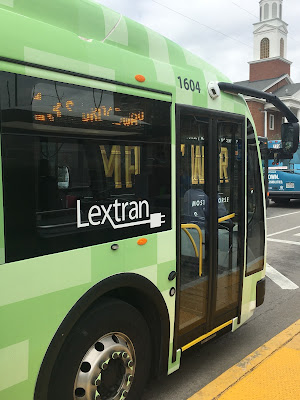 |
| Overhead charging station on High Street in Lexington, KY (Photo: Philipsen) |
So when the federal DOT issued grants for a “Low or No Emissions Vehicles Program” 10 cities in North America were awarded money to purchase new bus technology, Baltimore wasn't one of them. Instead of getting a few of those Teslas of public transit that re-charge via overhead induction charging stations, MTA abandoned the previous Governor's goal of an all hybrid bus fleet. In 2015 it began buying standard diesel buses because of the hefty price tag for the hybrids which combine diesel and battery power for better and quieter acceleration, better fuel economy and cleaner air.
The small transit agency Lextran that runs the transit for Fayette County of which Lexington, KY is part is one of the recipients of the grant that allowed them to replace 5 old diesel buses with the full electric bus of the Proterra series. Other grant recipients were Bostons MBTA and Dallas' DART. SEPTA (Philadelphia) plans to put 25 e-buses from the American e-bus maker Proterra into service they announced at the Democratic Convention in 2016.
 |
| Proterra bus model |
The Lextran buses stop for 15 minutes when they complete a route, a typical situation called a layover in which drivers get a break, change or catch up with the schedule. During that time an induction charger gets lowered over the top of the rear of the bus and recharges the battery in a minimum of about 7 minutes and a maximum of 10-12 minutes, depending on how far depleted the batteries were from the last round of service. A charge is supposed to last about 40-50 miles. Lextrans Assistant General Manager Jill Barnett explains the economics:
It is much more expensive to purchase an electric bus than a diesel bus. However, because we received the grant, we were able to receive these vehicles much cheaper than we would have been able to buy any other. Anytime you implement a new propulsion source like this, you do have some upfront capital expenses, the charging station being the main one. But over time, we hope to see a reduction in expenses because there’s less maintenance on the vehicle. There are fewer things to replace. And the cost of electricity is much more stable than the cost of diesel fuel. So, overall, we hope to recoup that.(Jill Barnett, Lextran)Lextran is running its e-bus on their #13 route with a charging station at the back of their downtown bus transit center. #13 happens to be the number of MTA's North Avenue route for which I have suggested a gold standard once it becomes the Gold Line when CityLink starts on June 18 of this year. As part of the gold standard ,in part funded through the North Avenue Rising federal grant, MTA and City which implement the grant in partnership, could consider running an emission free e-bus on the line as a pilot.
 |
| #13 Lextran bus (photo: Philipsen) |
 |
| Giant phone charger (Photo: Philipsen) |
Diesel emissions have become a focus of attention in the discussion about urban health, especially after the VW Diesel emission cheat scandal broke. Diesel engines have many advantages from an engineering perspective and use less fuel than a gas powered engine. But they have two health related disadvantages: The emit way more NOx due to high combustion temperatures and they emit a lot of fine particles. NOx is bad for the air quality and climate and fine particles are bad for lungs. Both components can be managed with the use of low sulfur diesel fuel (mandatory in the US), uric acid injection (NOx) and filters (particles) but they don't become emission free to the point a fully electric bus is.
Baltimore has been burnt by experimental buses. When the Circulator started up the City had purchased with great fanfare a bus that ran fully electric with a small gas turbine motor to recharge the batteries. The innovative made in America bus ran into trouble very quickly. The batteries didn't last through the hot summer days of Baltimore, their charger was too small, the buses were not ready for the wear and tear of everyday transit and the company went bankrupt. Buying green requires extra vetting and sometimes it is prudent not to jump on every innovative fad that is out there. Proterra claims that their bus is worthy, even though it only began prototyping as recent as 2004 and its body assembly appears to be somewhat less developed as on MTA's New Flyer buses that have been refined in the market for decades.
Proterra has sold more than 252 vehicles to 28 different municipal, university, and commercial transit agencies throughout North America. Proterra’s configurable EV platform, battery and charging options make its buses well suited for a wide range of transit and campus routes. (Website)On the other hand, health outcomes in areas of North Avenue are comparable to those of Rwanda while health in parts of Roland Park are similar to Switzerland with a whopping 20 year difference in average life expectancy. It seems that frequent reliable and emission free transit service would be a small but very doable step to improve quality of life along the North Avenue corridor.
Overseas e-bus pilots run in revenue service in Sweden and in Hamburg (Germany), buses are manufactured by Volvo.
Klaus Philipsen, FAIA
 |
| Hamburg e-bus made by Volvo |
No comments:
Post a Comment